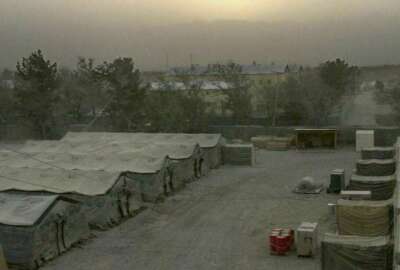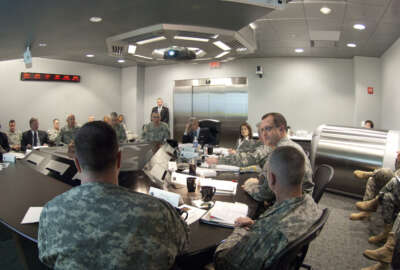
Army nearing final design decisions under new battlefield networking strategy
The Army plans a critical design review process next April, after which it will begin buying significant quantities of gear to build its integrated tactical...
It’s been a little more than two years since the Army’s chief information officer memorably declared that the battlefield network it has is not the network it needs. Now the service is nearly ready to start buying significant quantities of equipment to start constructing a network it believes will keep pace with technology and survive on a modern battlefield.
Over the past year, following a preliminary design review in May 2018, the designers of the Army’s integrated tactical network have been narrowing down the list of technology candidates and breaking them down into what the Army refers to as “capability sets” to be fielded over time, in two-year increments.
Officials plan to hold a critical design review next April, after which they’ll begin procuring equipment in significant-enough numbers to start building the first one: Capability Set 21.
“And we’re going to be fielding different things to different units,” Maj. Gen. Peter Gallagher, the director of the Army’s Network Cross Functional Team said in an interview for Federal News Network’s On DoD. “For the maneuver units, we’re fielding the integrated tactical network. It’s a set of program of record solutions combined with some commercial off-the-shelf and non-developmental items. We’re also fielding new capability to our expeditionary signal battalions that will give some of the non-maneuver units and a lot of the enabling formations a smaller, lighter, more expeditionary kind of communications capability. So Capability Set 21 is about making our units more expeditionary, and provide simpler solutions for soldiers to put into operation.”
The strategy of building the network in two-year increments was partly driven by cost, but also by the Army’s realization that trying to field the exact same equipment to all of its formations would ensure the technology was outdated by the time the process was finished, said Maj. Gen. David Bassett, the program executive officer for command, control and communications-tactical (PEO-C3T).
“In the past we’d say, OK, how many people are in the Army? And we’d need a program to field that to the entire Army. And we found ourselves in a position where we were kind of sticking with technology that was obsolete,” he said. “So this isn’t about delivering yesterday’s technology tomorrow. It’s acknowledging that even for those programs of record, we have to be looking for new technology about every two years at a minimum. And that’s not a pace that’s different than commercial industry. We’re making sure we have a rigorous process to integrate, test, contract for and field in a way that meets the timelines of commercial technology applied to the tactical space. And so this two-year capability set strategy is really about a different mindset both for the COTS equipment as well as for those existing programs of record.”
The latest strategy also attempts to reorient the focus of the Army’s own science and technology efforts. Officials say commercial providers are already investing billions of dollars in communications technologies that can be applied to military applications, so it makes little sense for government labs to duplicate their work.
Instead, Army S&T funding will be pointed toward Army-unique applications. In the meantime, the service will buy and integrate commercial solutions wherever it can. Bassett said emerging satellite communications offerings are among the most promising from the commercial sector.
“There are significant constellations going up in low earth orbit, mid-earth orbit, multi-billion dollar investments that are ongoing,” he said. “We want to be able to leverage, them recognizing there’s still a place for a military SATCOM as well in an environment where we’ve got to have systems that operate through jamming or electronic warfare. And so we’re not saying it’s either-or, we want to give commanders a range of options.”
Similarly, the Army is extremely eager to adopt the commercial world’s advances in cloud computing – but needs to adapt those technologies in ways that allow critical data to still be accessible on the battlefield when networks are unreliable or completely unavailable.
Related Stories
Even as it nears final selections for the first capability set, the Army is laying the groundwork for the next one: Capability Set 23.
Last week, officials invited more than 600 vendors to a meeting in Austin, Texas, where they began to outline the strategy for integrating more capability into the network during the next increment.
For companies who offer promising technologies that the Army isn’t quite sure how to integrate into a battlefield environment, officials intend to propose that they enter into cooperative research and development agreements (CRADAs) with Army labs.
“If a company is using their own research and development dollars or they’re coming on their own dime to demonstrate the capability and how it’ll integrate into the network, with a CRADA, they can do that,” Col. Garth Winterle, the Army’s lead official for the capability set process told reporters on a conference call. “With a CRADA, they can do that, and it doesn’t cost the government anything. But it also allows us to provide useful feedback so they can improve their products.”
But for much of Capability Set 23, the Army plans to make heavy use of Other Transaction Authority (OTA) because of what Winterle said is a “tight timeline” to begin assessing the next round of technologies.
In mid-December, the service plans to issue a call for white papers to an OTA consortium in which it will outline specific capability gaps it wants to close. Vendors who are part of the consortium will have 30 days to respond with their proposals. In February, the Army will hold a “shark tank” event to pick the firms who will receive OTA prototype funding.
“And then our intent would be to put the most promising solutions on contract right away,” Winterle said. “The challenge right now is the continuing resolution. Hopefully we’ll have a budget by then, because our prototyping resources are considered a new start, and it will have an impact for as long as there’s a continuing resolution. It won’t stop us from doing the shark tank, but it will delay when we can actually put some of the solutions on contract.”
Copyright © 2025 Federal News Network. All rights reserved. This website is not intended for users located within the European Economic Area.
Jared Serbu is deputy editor of Federal News Network and reports on the Defense Department’s contracting, legislative, workforce and IT issues.
Follow @jserbuWFED





